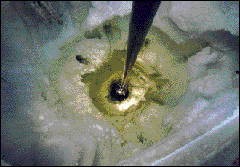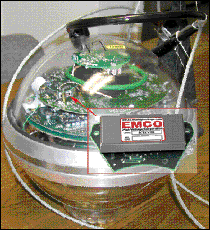Mike Doherty, Mike Janto and Mark Helmreich, Emco High Voltage Corp.
Of the high-energy particles thrown out by cataclysmic astrophysical sources in the universe, such as novas and gamma-ray bursts, only the elusive and weakly interacting neutrinos can be accurately traced to their points of origin. Neutrinos are produced in copious quantities, and their paths are unaffected by magnetic fields as they travel across the millennia at the velocity of light.
With the evolution of various technologies since the 1980s, the direct observation of neutrinos is now possible and is of importance in the study of the origin of the universe. New instruments built on massive scales enable scientists to study cosmic phenomena without waiting for a once-in-a-century miracle like a nearby supernova.
In what is considered the largest scientific instrument, Project Ice-Cube is being installed deep in the Antarctic ice (see "New South Pole Telescope Seeks Neutrinos in Ice," Photonics Spectra, April 2005, page 49). The neutrino telescope, designed by an international scientific collaboration headed by the University of Wisconsin-Madison and funded primarily by the National Science Foundation, is a 1-km3 array of nearly 5000 digital optical modules that are suspended like beads in a series of holes drilled with hot water to a depth of 2.4 km (Figure 1).

Figure 1. A string of 60 digital optical modules is lowered into a 1-m-wide shaft cut into the ice at the South Pole. The modules record the faint light produced when a neutrino collides with a water molecule. Courtesy of the National Science Foundation.
The collision of a neutrino with a proton in a water molecule in the ice produces a muon, which follows the original trajectory of the neutrino and emits faint blue Cerenkov radiation. Photomultiplier tubes in each digital optical module detect this light trail, convert it into a measurable electrical signal and send the digital representation via cable to instrumentation on the surface for preliminary analysis. This information is then uplinked to a satellite, sent to the university and made available to researchers.
Designing the digital optical modules for Project IceCube was no small feat. Each must have a sufficiently large dynamic recording range to capture and preserve a wide scope of data. The 5000-unit array must be able to time-tag the neutrino collisions with better than 5-ns precision for single-photon events as well as for those events of 100,000 photons or more. They also must operate without failure while frozen in the ice at −40 °C for many years. Further, because neutrinos are weakly interacting, only a handful of the collisions will occur each day, despite the fact that billions pass through the Earth each second. To capture these events and to generate precise data, the optical background noise must be very low.
To meet these extreme performance criteria, the basketball-size digital optical modules include low-noise photomultiplier tubes, optically perfect glass globes that can resist deep-sea-scale pressures and very precise local high-voltage DC power supplies with extremely accurate monitor feedback samples for programming each of 10 dynodes in the tubes. Primary logic and the high-voltage supply are housed in each module (Figure 2). This enables the low-power logic voltage in the cables from the surface to handle programming, power and data-collection chores, which has a sizeable impact when the cost of getting a gallon of diesel to the surface generators is considered.

Figure 2. The basketball-size digital optical modules feature miniature DC power supplies with a mean time to critical failure of more than 120 years, ensuring the reliability of the units. Courtesy of Emco High Voltage Corp.
The small-form-factor DC power supplies from Emco High Voltage Corp. in Sutter Creek, Calif., are in a 1.25-in.3 package that weighs less than 80 g. With an input programming voltage of 0 to 2 VDC, they generate up to 2000 VDC while consuming less than 300 mW. Because any ripple would reduce detector sensitivity and appear on the output monitor sample that drives programming accuracy, the power supplies exhibit less than 2-mV peak-to-peak ripple on the output. Adding to the demanding requirements, they are immune to unintended electrostatic discharge events and high-voltage shorts to logic pins, and do not radiate emissions or noise of their own.
The first string of modules was lowered into the Antarctic ice during 2004 and is encapsulated forever in this hostile environment. Because no opportunity exists to extract these units for repair or replacement, the long-term reliability of each power supply is "mission critical," as is a high mean time to critical failure. Using redundancy and protective circuits, the calculation for the power supply is greater than 120 years, more than meeting the criterion of 20 years defined by IceCube's designers.
As new applications emerge for subcompact high-voltage power supplies, this product and the manufacturing technologies developed for IceCube will provide a basis from which the new challenges will be addressed. Laboratory precision and control in a small, PC-mounted package at costs far below that of larger units opens the door to many design opportunities in mobile or handheld systems that demand reliability in hostile environments.